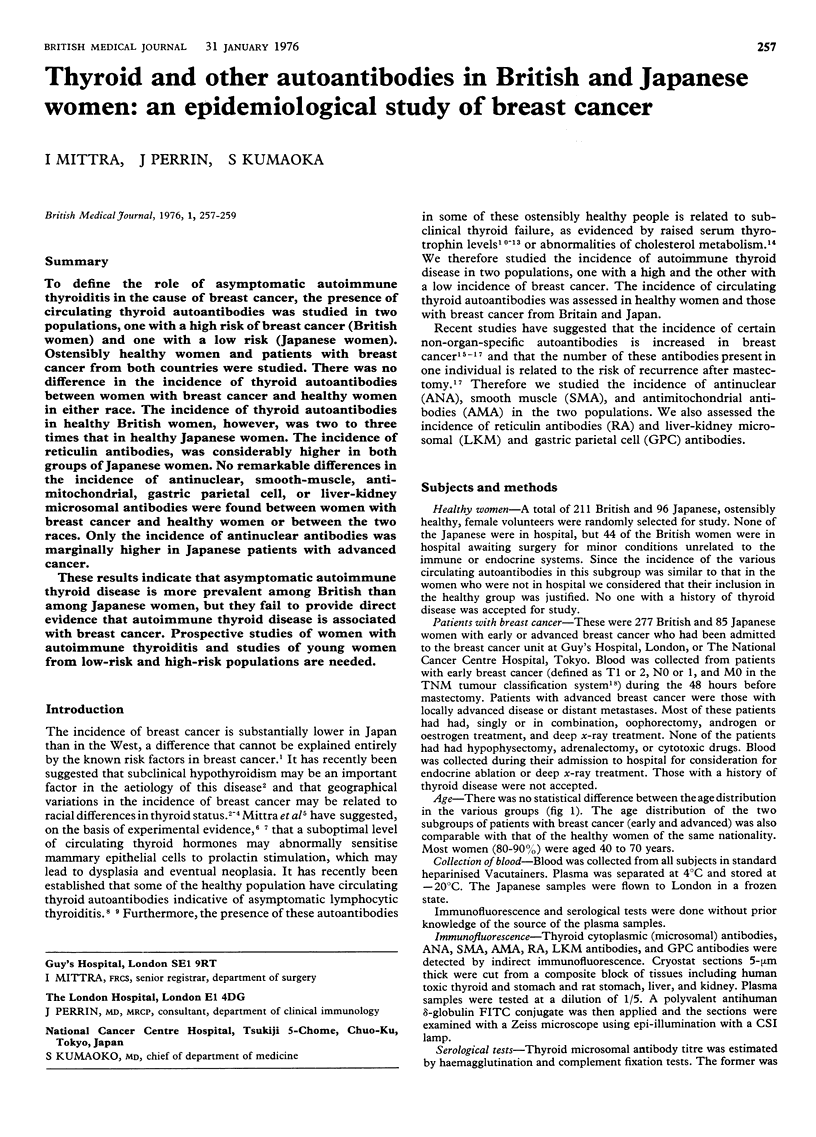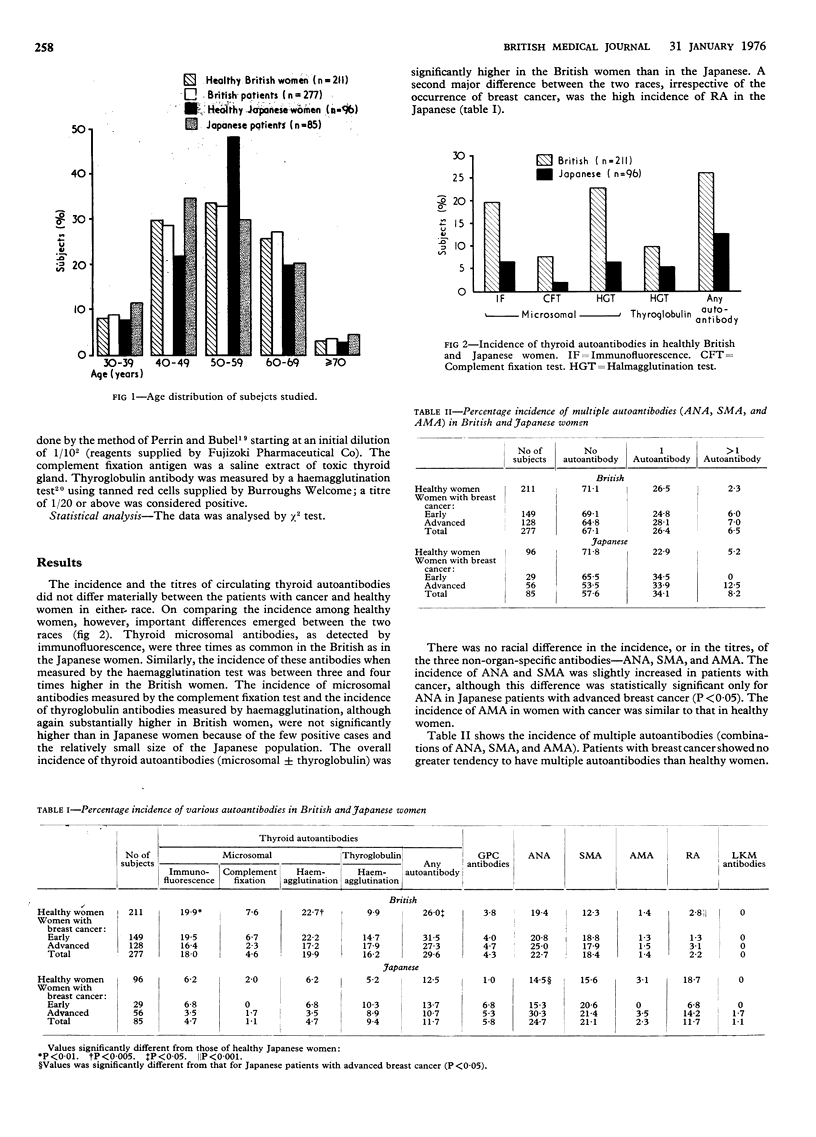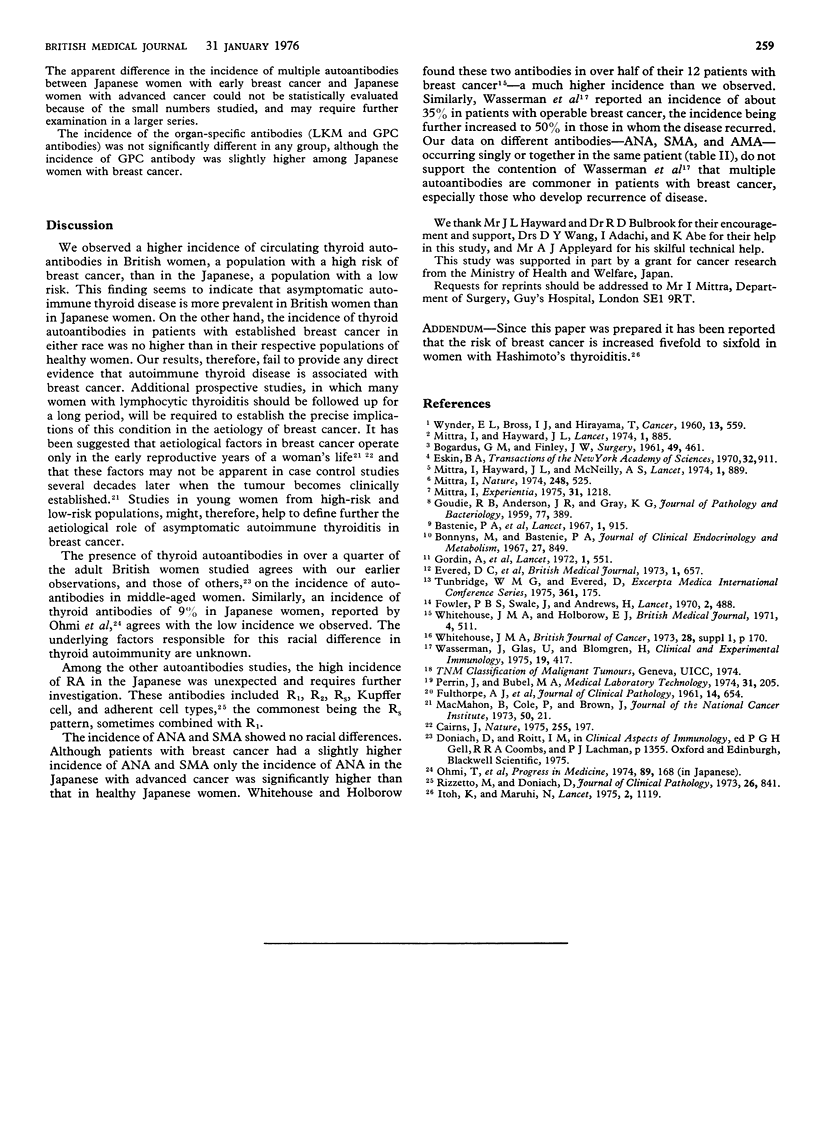Abstract
To define the role of asymptomatic autoimmune thyroiditis in the cause of breast cancer, the presence of circulating thyroid autoantibodies was studied in two populations, one with a high risk of breast cancer (British women) and one with a low risk (Japanese women). Ostensibly healthy women and patients with breast cancer from both countries were studied. There was no difference in the incidence of thyroid autoantibodies between women with breast cancer and healthy women in either race. The incidence of thyroid autoantibodies in healthy British women, however, was two to three times that in healthy Japanese women. The incidence of reticulin antibodies, was considerably higher in both groups of Japanese women. No remarkable differences in the incidence of antinuclear, smooth-muscle, antimitochondrial, gastric parietal cell, or liver-kidney microsomal antibodies were found between women with breast cancer and healthy women or between the two races. Only the incidence of antinuclear antibodies was marginally higher in Japanese patients with advanced cancer. These results indicate that asymptomatic autoimmune thyroid disease is more prevalent among British than among Japanese women, but they fail to provide direct evidence that autoimmune thyroid disease is associated with breast cancer. Prospective studies of women with autoimmune thyroiditis and studies of young women from low-risk and high-risk populations are needed.
Full text
PDF


Selected References
These references are in PubMed. This may not be the complete list of references from this article.
- Bastenie P. A., Bonnyns M., Neve P., Vanhaelst L., Chailly M. Clinical and pathological significance of asymptomatic atrophic thyroiditis. A condition of latent hypothyroidism. Lancet. 1967 Apr 29;1(7496):915–918. doi: 10.1016/s0140-6736(67)91486-9. [DOI] [PubMed] [Google Scholar]
- Bonnyns M., Bastenie P. A. Serum thyrotrophin in myxedema and in asymptomatic atrophic thyroiditis. J Clin Endocrinol Metab. 1967 Jun;27(6):849–854. doi: 10.1210/jcem-27-6-849. [DOI] [PubMed] [Google Scholar]
- Cairns J. Mutation selection and the natural history of cancer. Nature. 1975 May 15;255(5505):197–200. doi: 10.1038/255197a0. [DOI] [PubMed] [Google Scholar]
- FULTHORPE A. J., ROITT I. M., DONIACH D., COUCHMAN K. A stable sheep cell preparation for detecing thyroglobulin auto-antibodies and its clinical applications. J Clin Pathol. 1961 Nov;14:654–660. doi: 10.1136/jcp.14.6.654. [DOI] [PMC free article] [PubMed] [Google Scholar]
- Fowler P. B., Swale J., Andrews H. Hypercholesterolaemia in borderline hypothyroidism. Stage of premyxoedema. Lancet. 1970 Sep 5;2(7671):488–491. doi: 10.1016/s0140-6736(70)90111-x. [DOI] [PubMed] [Google Scholar]
- GOUDIE R. B., ANDERSON J. R., GRAY K. G. Complement-fixing antithyroid antibodies in hospital patients with asymptomatic thyroid lesions. J Pathol Bacteriol. 1959 Apr;77(2):389–400. doi: 10.1002/path.1700770208. [DOI] [PubMed] [Google Scholar]
- Ito K., Maruchi N. Breast cancer in patients with Hashimoto's thyroiditis. Lancet. 1975 Dec 6;2(7945):1119–1121. doi: 10.1016/s0140-6736(75)91006-5. [DOI] [PubMed] [Google Scholar]
- MacMahon B., Cole P., Brown J. Etiology of human breast cancer: a review. J Natl Cancer Inst. 1973 Jan;50(1):21–42. doi: 10.1093/jnci/50.1.21. [DOI] [PubMed] [Google Scholar]
- Mittra I., Hayward J. L. Hypothalamic-pituitary-thyroid axis in breast cancer. Lancet. 1974 May 11;1(7863):885–889. doi: 10.1016/s0140-6736(74)90344-4. [DOI] [PubMed] [Google Scholar]
- Mittra I., Hayward J. L., McNeilly A. S. Hypothalamic-pituitary-prolactin axis in breast cancer. Lancet. 1974 May 11;1(7863):889–891. doi: 10.1016/s0140-6736(74)90345-6. [DOI] [PubMed] [Google Scholar]
- Mittra I. Mammotropic effect of prolactin enhanced by thyroidectomy. Nature. 1974 Apr 5;248(448):525–526. doi: 10.1038/248525a0. [DOI] [PubMed] [Google Scholar]
- Mittra I. Potency of thyroid hormone analogues in suppressing prolactin-mediated mammary growth in thyroidectomized rats. Experientia. 1975 Oct 15;31(10):1218–1221. doi: 10.1007/BF02326803. [DOI] [PubMed] [Google Scholar]
- Perrin J., Bubel M. A. Assessment of a haemagglutination test for thyroid microsomal antibody. Med Lab Technol. 1974 Jul;31(3):205–211. [PubMed] [Google Scholar]
- Rizzetto M., Doniach D. Types of 'reticulin' antibodies detected in human sera by immunofluorescence. J Clin Pathol. 1973 Nov;26(11):841–851. doi: 10.1136/jcp.26.11.841. [DOI] [PMC free article] [PubMed] [Google Scholar]
- WYNDER E. L., BROSS I. J., HIRAYAMA T. A study of the epidemiology of cancer of the breast. Cancer. 1960 May-Jun;13:559–601. doi: 10.1002/1097-0142(196005/06)13:3<559::aid-cncr2820130322>3.0.co;2-0. [DOI] [PubMed] [Google Scholar]
- Wasserman J., Glas U., Blomgren H. Autoantibodies in patients with carcinoma of the breast. Correlation with prognosis. Clin Exp Immunol. 1975 Mar;19(3):417–422. [PMC free article] [PubMed] [Google Scholar]
- Whitehouse J. M. Circulating antibodies in human malignant disease. Br J Cancer Suppl. 1973 Aug;1:170–174. [PMC free article] [PubMed] [Google Scholar]
- Whitehouse J. M., Holborow E. J. Smooth muscle antibody in malignant disease. Br Med J. 1971 Nov 27;4(5786):511–513. doi: 10.1136/bmj.4.5786.511. [DOI] [PMC free article] [PubMed] [Google Scholar]


